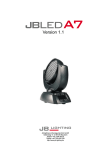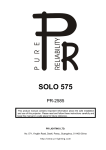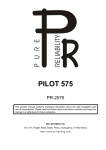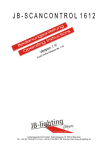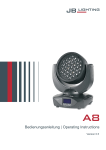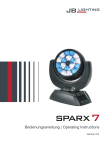Download Varyscan* 4 1200 HMI
Transcript
Varyscan* 4 1200 HMI Made in Germany by JB-lighting JB lighting Lichtanlagentechnik GmbH Sallersteigweg 15, 89134 Blaustein, Tel. +49 7304 9617-0, Fax. -99 Varyscan* 4 1200 HMI Bedienungsanleitung deutsch 2 Seite 05-38 Varyscan* 4 1200 HMI Operating Instructions english 3 Page 39-70 Varyscan* 4 1200 HMI Bedienungsanleitung 4 Varyscan* 4 1200 HMI Varyscan* 4 1200 HMI Made in Germany by JB-lighting Version 1.1 Vorwort Sie haben sich für den Kauf des Varyscan* 4 1200 HMI von JB-lighting entschieden. Vielen Dank für das entgegengebrachte Vertrauen. 5 Varyscan* 4 1200 HMI Der Varyscan* 4 1200 HMI gibt Ihnen viele Möglichkeiten, Ihre gewünschten Effekte zu realisieren. Lesen Sie zuerst in aller Ruhe diese Bedienungsanleitung durch, denn sie enthält Informationen, die Ihnen gewährleisten, Ihren Varyscan* voll zu nutzen. Viel Spaß und gute Shows wünscht Ihnen JB-lighting Inhaltsverzeichnis A Bedienungsanleitung Deckblatt Vorwort Inhaltsverzeichnis 6 7 6 Varyscan* 4 1200 HMI Abbildung Varyscan* 1200 HMI Rückansicht und Lage der Bedienelemente Auspacken der Varyscan* Anlage Brenner einsetzen / auswechseln Inbetriebnahme der Anlage DIP-Schaltereinstellungen Betriebsartenwahl DMX-Adresseneinstellung Eine bestimmte DMX-Adresse einstellen Auswechseln der Gobos GOBO Maße 8 9 10 10 11 11 12 14 17 18 18 B Serviceanleitung Fehlerbehebung Abgleichen des Spiegelanschlages Einstellen der "Motorbremse" Regelmäßige Wartungsarbeiten Allgemeine Information zum DMX512 Protokoll Kanalbelegung Varyscan* 4 1200 HMI Belegung DMX-IN / DMX-OUT Technische Daten Epromwechsel / Software Update Stromlaufplan Varyscan* 4 1200 HMI Belegung der Steckerleisten und Jumper Stückliste Platine VS4 1200 HMI Bestückungsplan Abbildung VS4 1200 HMI 7 19 19 20 20 21 22 30 30 30 31 32 33 36 Varyscan* 4 1200 HMI Rückansicht und Lage der Bedienelemente 8 Varyscan* 4 1200 HMI Belegung der DMX-Buchsen DMX-Eingang Pin Nr. 1 2 3 4 5 Signal Ground DMX DMX + frei +5V DMX-Ausgang Kabelfarbe schwarz weiß rot gr/sw Pin Nr. 1 2 3 4 5 Auspacken der Varyscan* Anlage Vor Ihnen befindet sich die komplette Varyscan*-Anlage. 9 Signal Ground DMX DMX + frei frei Kabelfarbe schwarz weiß rot Varyscan* 4 1200 HMI Entnehmen Sie zuerst alle Teile aus den Kartons. • • Varyscan* 1200 HMI diese Anleitung Prüfen Sie, ob alle Teile in der Lieferung enthalten sind. Sollten Sie einen Transportschaden feststellen oder sollten Sie feststellen, daß Teile fehlen, teilen Sie dies bitte sofort dem Transportunternehmen bzw. Ihrem Händler mit. Die Verpackung Ihrer Varyscan* wird -wenn möglich- aus Umweltgründen mehrfach verwendet. Sie erhalten bei Rückgabe der Verpackungen eine Teilgutschrift. Bitte machen Sie von der Rückgabe im Sinne unserer Umwelt Gebrauch. Wir bitten Sie aus diesem Grunde auch um Verständnis, falls Sie evtl. eine gebrauchte Verpackung bzw. Inlay erhalten sollten. Brenner einsetzen/auswechseln HINWEIS: Vor dem Öffnen Netzstecker ziehen!! Öffnen Sie den Deckel (Aufschrift Varyscan 4 1200HMI) Ihres Varyscan* mit einem passenden Kreuzschlitzschraubendreher und heben Sie diesen ab. Jetzt können Sie im hinteren Drittel des Varyscan* die Brennerfassung erkennen.(Skizze Seite 4) Lösen Sie nun die beiden Muttern 1 und 2 und entnehmen Sie den Brenner aus der Fassung. Setzen Sie nun den neuen HMIBrenner in die Fassung ein und drehen die beiden Muttern 1 und 2 von Hand fest. Der "Absaugstutzen" des Brenners darf auf keinen Fall in Richtung des Hohlspiegels bzw. in Richtung der Linsen zeigen (Skizze Seite 4), er sollte in Richtung des Bodenblechs oder des Deckels zeigen. Achten Sie auf einen festen Sitz des Brenners. Achtung: Berühren Sie niemals beim 1200HMI-Brenner den Glaskörper selbst! Eine Justierung des Brenners entfällt. Inbetriebnahme der Anlage 1. Varyscan* aufhängen Um die optimale Funktionsfähigkeit der Varyscan* auszuschöpfen, sollten Sie die Spots so hoch wie möglich aufhängen. 10 Varyscan* 4 1200 HMI 2. Varyscan* einstellen Alle Spots sollten im selben Winkel hängen, das heißt der gedachte Winkel zwischen Lot und Varyscan* sollte bei allen Varyscan* gleich sein. 3. Varyscan* verkabeln Spannungsversorgung: Lassen Sie von einem Fachmann an das offene Ende des Anschlußkabels einen SchukoStecker anbringen, oder lassen Sie das Kabel direkt an 230 Volt 50 Herz anschließen. Signalverkabelung: Verbinden Sie den Ausgang Ihres DMX-Controllers mit dem ersten Varyscan* (Controller DMXOut; Varyscan* DMX-In) mit Hilfe eines 5poligen XLR-Kabels. Stellen Sie nun mit Hilfe weiterer 5pol-XLR Kabel die Verbindung zwischen den Varyscan* her. Achten Sie darauf, daß beim letzten Scan im DMX-Out ein Endstecker (XLR-Stecker mit einem Widerstand von 100 Ohm zwischen Pin 2 und 3) steckt. 4. Einstellen der DIP-Schalter Sie haben an den DIP-Schaltern Nr.1 und Nr.2 folgende Einstellmöglichkeiten: • Initialisierungsmodus • Testmodus • Farbwechsel stufenlos • Kanalauswahl des Varyscan* • Reset über DMX • DMX-Adresse Initialisierungsmodus: Dieser Modus dient zur Einstellung und zur Grundinitialisierung des Varyscan* (wird vom Hersteller durchgeführt.) Testmodus: Um mit einfachen Mitteln die Funktionvielfalt Ihres Varyscan* zu sehen, schalten Sie den Varyscan* in den Testmodus, indem Sie am DIP-Schalter Nr.2 den Schalter 3 auf off und den Schalter 2 auf on stellen (siehe auch Typenschild). Jetzt stecken Sie den Scanner ein, und er zeigt Ihnen einen großen Teil seiner Funktionen. Einstellungen am DIP-Schalter NR.2 Bevor wir zur DMX-Adresseneinstellung kommen, müssen wir zuerst am DIP-Schalter Nr. 2 eine bestimmte Betriebsart auswählen, um danach die richtige Adressauswahl zu treffen. Sie haben am DIP-Schalter Nr.2 4 Schalter, mit denen Sie folgende Funktionen auswählen können. Farbwechsel stufenlos: DIP-Schalter Nr.2 Schalter 1 11 Varyscan* 4 1200 HMI d.h. wenn diese Funktion eingeschaltet ist, entspricht jeder DMX-Wert zwischen 0 und 128 einer Farbradstellung, Sie können somit nicht nur Halbfarben erzeugen, sondern auch 1/3-2/3 Farben oder 1/4-3/4Farben usw. Um diese Funktion zu wählen, schalten Sie am DIP-Schalter Nr.2 den Schalter 1 auf on (siehe auch Typenschild) ist der Schalter 1 auf off, so haben Sie nur Voll- bzw. Halbfarben. Betriebsartenwahl: DIP-Schalter Nr.2 Schalter 2 und 3 Es stehen Ihnen insgesamt 3 DMX-Kanal-Formate zur Verfügung, die im folgenden genauer erklärt werden (Kurzbeschreibung siehe Typenschild). 1. JB-lighting 8 Kanal Kanal 1 X-Achse Kanal 2 Y-Achse Kanal 3 Gobo Kanal 4 Farbe Kanal 5 Shutter/Dimmer Kanal 6 Iris Kanal 7 drehbare Gobos (Positionierung und Rotation) Kanal 8 Effektrad DIP-Schaltereinstellung: DIP-Schalter Nr.2 Schalter 2 und 3 off 2. 6 Kanal (Clay Paky - Goldenscan 3 kompatibel) Kanal 1 Kanal 2 Kanal 3 Kanal 4 Kanal 5 Kanal 6 Iris und Gobodreh Farbe Gobo- und Effektrad Dimmer / Shutter X-Achse Y-Achse DIP-Schalterstellung: DIP-Schalter Nr.2 Schalter 2 off Schalter 3 on 12 Varyscan* 4 1200 HMI 3. JB-lighting 6 Kanal Kanal 1 Kanal 2 Kanal 3 Kanal 4 Kanal 5 Kanal 6 X-Motor Y-Motor Gobo Farbe Dimmer/Shutter Iris / Gobodreh DIP-Schaltereinstellung: DIP-Schalter Nr.2 Schalter 2 und 3 on Reset über DMX: DIP-Schalter Nr.2 Schalter 4 Wenn Sie an Ihren Varyscan* von Ihrem DMX-Pult aus einen Reset durchführen wollen, so müssen Sie am DIP-Schalter Nr. 2 den Schalter 4 auf on stellen. Jetzt haben Sie die Möglichkeit, wenn Sie über den Gobokanal den DMX-Wert 255 übertragen, an Ihrem Varyscan* einen Reset durchzuführen. Ist am DIP-Schalter Nr.2 der Schalter 4 auf off, so ist der Reset über DMX ausgeschaltet. DMX-Adresse einstellen: DIP-Schalter Nr. 1 Schalter 1 bis 9 Je nach gewählter Betriebsart müssen nun die DMX-Adressen wie folgt eingestellt werden. Die Adressierung erfolgt nach dem binären Zahlensystem und muß bei den beiden Sechs-KanalBetriebsarten in 6er-Schritten erfolgen. Varyscan* Nr. DMX-Adresse 1 1 Schaltereinstellung 13 Varyscan* 4 1200 HMI 2 7 3 13 4 19 5 25 6 31 7 37 Varyscan* Nr. DMX-Adresse 8 43 9 49 Schaltereinstellung 14 Varyscan* 4 1200 HMI 10 55 11 61 12 67 In der 8-Kanal-Betriebsart müssen die Adressen in 8er-Schritten eingestellt werden. Varyscan* Nr. DMX-Adresse 1 1 2 9 3 17 Varyscan* Nr. DMX-Adresse 4 25 5 33 6 41 Schaltereinstellung Schaltereinstellung 15 Varyscan* 4 1200 HMI 7 49 8 57 9 65 10 73 11 81 12 89 Bestimmung der DIP-Schaltereinstellung für bestimmte DMX-Adressen Die einzelnen DIP-Schalter entsprechen den oben angezeigten Werten. Soll nun eine bestimmte DMX-Adresse eingestellt werden, so muß diese nur aus den einzelnen Werten zusammengezählt werden. Beispiel: DMX-Adresse "45" 32 + 8 + 4 + 1 = 45 SW6 SW4 SW3 SW1 on on on on Die restlichen DIP-Schalter SW9 SW8 SW7 SW5 SW2 bleiben auf "OFF". 16 Varyscan* 4 1200 HMI Auswechseln der Gobos Öffnen Sie den Deckel mit der Beschriftung Varyscan* 4 1200 HMI, indem Sie die sechs Kreuzschlitzschrauben herausdrehen. Jetzt können Sie die Gobos am Goborad aus der Halterung drücken und die neuen Gobos einsetzen. Achten Sie darauf, daß das Gobo exact mit den Schlitzen in der Halterung einrastet. Wenn das Gobo richtig eingesetzt ist, läßt es sich ganz leicht in der Halterung bewegen. Jetzt können Sie den Deckel wieder schließen. Gobo-Maße: Sie haben an Ihrem Varyscan* 4 1200 HMI die Möglichkeit zwei verschiedene Gobo-Maße einzusetzen. 1. Gobos im JB-Format: Außendurchmesser: Nutzdurchmesser: 68,0 mm 49,0 mm Vorteil: Durch die Ausklinkungen mit 1mm Tiefe mit 120°-Teilung ist gewährleistet, daß sich die Gobos in der Gobohalterung auf dem Goborad nicht wie bei anderen Herstellern drehen. 17 Varyscan* 4 1200 HMI 2. Standardformat: (M-Size) Außendurchmesser: Nutzdurchmesser: 66,0 mm 49,0 mm B Serviceanleitung Fehlerbehebung Fehler Behebung des Problems Das Gerät arbeitet überhaupt nicht 16 Ampere-Sicherung des Gerätes (kein Lüftergeräusch zu hören) austauschen (Skizze Seite 5) Der Brenner des Gerätes leuchtet nicht, aber 1. Der Brenner ist defekt, der Brenner muß die Elektronik funktioniert, getauscht werden d.h. die Motoren funktionieren 2. Der Temperaturschalter des Gerätes hat ausgelöst. Stecken Sie Ihren Varyscan* aus und stecken Sie Ihn nach ca. 15 Minuten wieder ein. Kontrollieren Sie nun, ob beide Lüfter noch laufen, und ob diese sauber sind. Sollte ein Lüfter defekt sein, so lassen Sie diesen von einem Fachmann oder dem Hersteller austauschen. Sollte der Scanner immer wieder abschalten, wenden Sie sich bitte an Ihren Händler DMX-Eingang funktioniert nicht DIP-Schaltereinstellung kontrollieren Abgleichen des Spiegelanschlages 18 Varyscan* 4 1200 HMI Um den Spiegel an Ihrem Varyscan* 1200 HMI abzugleichen, gehen Sie wie folgt vor: Stellen Sie am DIP-Schalter Nr. 1 den Initialisierungsmodus ein (DIP-Schalterstellung siehe Seite 7) und schalten Sie Ihren Varyscan* ein. Warten Sie nun, bis der Scanner seine Initialisierung durchlaufen hat und alle Motoren stehen. Lösen Sie nun zuerst mit einem Innensechskantschlüssel (Schlüsselweite 2,0 mm) die Schraube Nr. 1. Drehen Sie nun den Spiegelbügel in Richtung des Anschlages bis zu einem Abstand von 0,5mm. Ziehen Sie nun die Schraube Nr. 1 wieder fest. Achten Sie beim Festziehen der Schraube auf die richtige Einstellung des federnden Druckstückes (siehe untere Skizze). Lösen Sie nun die Schraube Nr. 2 und drehen Sie den Y-Motor in Richtung Spiegelbügel und stellen somit zwischen dem Anschlag und dem Spiegelbügel einen Abstand von 0,5 mm ein. Achtung: Achten Sie darauf, daß der Y-Motor nicht vom Spiegelbügel weggedrückt wird, da sonst die Klemmung des Y-Motors nicht mehr funktioniert. Die Reibefläche des Motors muß ganz am Kunststoffdrehteil anliegen. Ziehen Sie nun die Schraube Nr. 2 wieder fest. Einstellen der "Motorbremse" Die Motorbremse ist vom Prinzip bei allen Motoren im Scan gleich. Sie setzt sich aus 3 Spezialteilen (Tellerfedern, Stahllaserteil, Kunststoffscheibe). Diese drei Teile sind in der folgenden Reihenfolge übereinander zu stapeln: 1. Motor 2. Telerfedern 3. Stahllaserteil 4. Kunststoffscheibe 5. zu montierendes Teil. Jetzt wird das zu montierende Teil fest auf die Achse des Motors gedrückt, bis die Tellerfedern komplett zusammengedrückt sind, anschließend muß das zu befestigende Teil um ca. 0,5mm zurückgezogen werden und die Befestigungsschraube(n) muß/müssen angezogen werden. Jetzt ist die Motorbremse optimal eingestellt Regelmäßige Wartungsarbeiten Achtung: Vor dem Öffnen des Gerätes Netzstecker ziehen! Öffnen Sie hierzu das Gehäuse, in dem Sie die Kreuzschlitzschrauben an der Oberseite des Varyscan* herausdrehen. Um die Einschübe Ihres Varyscan* herausnehmen zu können, müssen Sie die zwei silbernen Schrauben auf jedem Seitenteil in der Höhe der Einschübe herausdrehen. Erst jetzt lassen sich die Einschübe herausnehmen. (Skizze Seite 4) 19 Varyscan* 4 1200 HMI Achtung: Vergessen Sie nicht beim Abschluß Ihrer Wartungsarbeiten die Einschübe wieder zu verriegeln, indem Sie die silbernen Schrauben wieder vorsichtig hineindrehen. 1. Reinigung aller optischen Teile: Sie sollten in regelmäßigen Abständen die optischen Teile des Varyscan* reinigen, um wieder die maximale Helligkeit des Scanners herzustellen. Entnehmen Sie, nachdem Sie das Gehäuse wie oben beschrieben geöffnet haben, nun den Effektradeinschub (Skizze Seite 4) und legen diesen vor Ihnen auf eine Unterlage. Nehmen Sie nun ein fusselfreies Tuch und etwas Fensterputzmittel und reinigen Sie die Effektfilter auf dem Effektrad. Anschließend reinigen Sie noch die beiden Linsen (Skizze Seite 4). Um das Objektiv leichter reinigen zu können, lösen Sie die Objektivhalteschraube und entnehmen das Objektiv. Nun können Sie es leicht innen und außen reinigen. Entnehmen Sie nun noch den Farbradeinschub, um die Farbfilter zu reinigen. Setzen Sie anschließend das Objektiv, den Effektradeinschub und den Farbradeinschub wieder ein. Vergessen Sie nicht, die Objektivhalteschraube wieder anzuziehen. 2. Reinigung der Lüftung: Sie sollten in regelmäßigen Abständen die Funktion der Lüfter überprüfen. Vor allem sollten Sie darauf achten, daß die Lufteinlässe und das Innere des Varyscan* frei von Fusseln und sonstigem Staub sind. Hierzu öffnen Sie am besten beide Deckel des Varyscan*, indem Sie die Kreuzschlitzschrauben an den Deckeln herausdrehen. Jetzt saugen Sie Ihren Varyscan* mit einem Staubsauger vorsichtig aus. Schrauben Sie nun die beiden Deckel wieder zu. Achten Sie darauf , daß Sie für den kleineren Deckel wieder die Blechschrauben verwenden. Achtung: Achten Sie darauf, daß Sie beim Reinigen des Scanners keine Teile verbiegen oder beschädigen. 3. Ölen der drehbaren Gobos Besorgen Sie sich eine handelsübliche Spritze mit einer dünnen Nadel (Schleifen Sie die Spitze stumpf - keine Verletzungsgefahr!!) und befüllen Sie diese mit unserem Spezialöl. Verwenden Sie auf keinen Fall ein anderes Öl, da unser Öl speziell angemischt wird. Spritzen Sie nun das Öl zwischen die Messingzahnräder und die Messingscheibe und drehen Sie dabei von Hand die drehbaren Gobos. Achtung: Nicht zuviel Öl verwenden!! Allgemeine Informationen zum DMX512-Protokoll Das DMX512-Protokoll ist wie man aus dem Namen schon erkennen kann in 512 Adressen eingeteilt. Über diese 512 Adressen kann frei verfügt werden. Um nun verschiedene Geräte an einen DMX-Controller anschließen zu können, muß zuerst die Anzahl der DMX-Kanäle für jedes Gerät ermittelt werden. Die Kanalbelegung eines Scanners könnte beispielsweise wie folgt aussehen. Kanal 1 X-Bewegung Kanal 2 Y-Bewegung Kanal 3 Gobo / Effektrad Kanal 4 Farbe 20 Varyscan* 4 1200 HMI Kanal 5 Kanal 6 Shutter / Dimmer Iris / Gobopositionierung / Goborotation Damit nun nicht jedes angeschlossene DMX-Gerät die gleichen Funktionen ausführt, werden die Geräte hintereinander adressiert; d.h. das Erste verwendet die ersten sechs Adressen (gilt für ein Gerät mit sechs Kanälen) und das Zweite verwendet die nächsten sechs Adressen (Gerät mit sechs Kanälen) der 512 DMX-Adressen (Beispiel Varyscan* siehe Seite 10). Kanalbelegung Varyscan* 4 1200 HMI 1. JB lighting 8 Kanäle Kanal 1 Kanal 2 Kanal 3 Kanal 4 Kanal 5 Kanal 6 Kanal 7 Kanal 8 X-Bewegung Y-Bewegung Gobo Farbe Shutter / Dimmer Iris drehbare Gobos (Positionierung und Rotation) Effektrad Kanal 1 = x (pan) 170 Grad Kanal 2 = y (tilt) 90 Grad Kanal 3 = Gobo Gobo 0 (Beam) Gobo 1 Gobo 2 Gobo 3 Gobo 4 wenn am DIP-Schalter Nr. 2 Schalter 4 auf "ON" Gobo 4 Reset Kanal 4 = Farbe Farbe 0 (weiß) Farbe 1 Farbe 2 Farbe 3 Farbe 4 Farbe 5 DMX DMX DMX DMX DMX - DMX 128 DMX DMX DMX DMX DMX DMX DMX 21 000 032 064 096 128 000 008 016 024 032 040 031 063 095 127 255 - 254 255 - 007 015 023 031 039 047 Varyscan* 4 1200 HMI Farbe 6 Farbe 7 Farbe 8 Farbe 9 Farbe 10 Farbe 11 Farbe 12 Farbe 13 Farbe 14 Farbe 15 Farbraddreh - Geschwindigkeit 1(langsam) Farbraddreh - Geschwindigkeit 7(schnell) Kanal 5 = Dimmer / Shutter Shutter Dimmer zu --> Blackout Dimmer erstes Licht zu erkennen Dimmer Dimmer voll offen Shutter schlagartig offen Shuttersequenz 0,98 Blitze/sec Shuttersequenz 1,04 Blitze/sec Shuttersequenz 1,16 Blitze/sec Shuttersequenz 1,23 Blitze/sec Shuttersequenz 1,33 Blitze/sec Shuttersequenz 1,43 Blitze/sec Shuttersequenz 1,52 Blitze/sec Shuttersequenz 1,60 Blitze/sec Shuttersequenz 1,67 Blitze/sec Shuttersequenz 1,77 Blitze/sec Shuttersequenz 1,85 Blitze/sec Shuttersequenz 1,96 Blitze/sec Shuttersequenz 2,17 Blitze/sec Shuttersequenz 2,27 Blitze/sec Shuttersequenz 2,50 Blitze/sec Shuttersequenz 2,70 Blitze/sec Shuttersequenz 3,10 Blitze/sec Shuttersequenz 3,50 Blitze/sec Shuttersequenz 3,63 Blitze/sec Shuttersequenz 4,00 Blitze/sec Shuttersequenz 4,65 Blitze/sec Shuttersequenz 4,88 Blitze/sec Shuttersequenz 5,26 Blitze/sec Shuttersequenz 5,88 Blitze/sec Shuttersequenz 6,25 Blitze/sec Shuttersequenz 6,90 Blitze/sec Shuttersequenz 7,14 Blitze/sec Shuttersequenz 7,30 Blitze/sec Shuttersequenz 7,40 Blitze/sec Shuttersequenz 8,00 Blitze/sec DMX DMX DMX DMX DMX DMX DMX DMX DMX DMX DMX DMX 048 056 064 072 080 088 096 104 112 120 128 - 055 063 071 079 087 095 103 111 119 127 255 DMX 0 DMX 19 DMX 20 - 127 DMX 128 - 137 DMX 138 - 139 DMX 140 - 151 DMX 152 DMX 153 DMX 154 DMX 155 DMX 156 DMX 157 DMX 158 DMX 159 DMX 160 DMX 161 DMX 162 DMX 164 DMX 166 DMX 168 DMX 170 DMX 172 DMX 174 DMX 176 DMX 178 DMX 180 DMX 185 DMX 190 DMX 195 DMX 200 DMX 205 DMX 210 DMX 215 DMX 220 DMX 225 22 Varyscan* 4 1200 HMI Shuttersequenz 8,65 Blitze/sec Shuttersequenz 9,25 Blitze/sec Shuttersequenz 10,0 Blitze/sec Shutter offen DMX DMX DMX DMX 244 - 230 235 243 255 Kanal 6 = Iris Iris (linear) DMX 000 - 255 Kanal 7 = drehbare Gobos (Positionierung und Rotation) 0° 180° 360° 540° Linksdrehung (schnell) Linksdrehung (langsam) Drehung stop Rechtsdrehung (langsam) Rechtsdrehung (schnell) DMX 000 DMX 063 DMX 126 DMX 191 DMX 192 DMX 222 DMX 223 - 224 DMX 225 DMX 255 Kanal 8 = Effektrad offen Kunstlichtfilter Tageslichtfilter Prisma Floodfilter stufenlos von Flood bis offen DMX DMX DMX DMX DMX DMX 000 032 064 096 128 160 - 031 063 095 127 159 255 2. 6 Kanäle (Clay Paky Goldenscan 3 kompatibel) Kanal 1 Iris und Gobodreh Kanal 2 Farbe Kanal 3 Gobo und Effektrad Kanal 4 Dimmer / Shutter Kanal 5 X-Achse Kanal 6 Y-Achse Kanal 1 = Iris und Gobodreh Iris zu Gobo 1. Position Iris ganz auf Gobo 1. Position 2. Goboposition 3. Goboposition .......... 360° positioniert 540° positioniert links Dreh höchste Geschwindigkeit links Dreh langsamste Geschwindigkeit Dreh Stop DMX DMX DMX DMX 0 - 64 65 66 DMX DMX DMX DMX DMX 223 - 23 191 191 192 222 224 Varyscan* 4 1200 HMI rechts Dreh langsamste Geschwindigkeit rechts Dreh höchste Geschwindigkeit DMX DMX 225 255 Kanal 2 = Farbe Farbe 0 (weiß) Farbe 1 Farbe 2 Farbe 3 Farbe 4 Farbe 5 Farbe 6 Farbe 7 Farbe 8 Farbe 9 Farbe 10 Farbe 11 Farbe 12 Farbe 13 Farbe 14 Farbe 15 Farbraddreh - Geschwindigkeit 1(langsam) Farbraddreh - Geschwindigkeit 7(schnell) DMX DMX DMX DMX DMX DMX DMX DMX DMX DMX DMX DMX DMX DMX DMX DMX DMX DMX 000 008 016 024 032 040 048 056 064 072 080 088 096 104 112 120 128 Kanal 3 = Gobo und Effektrad weiß Kunstlichtfilter Tageslichtfilter Prisma Floodfilter Gobo 1 weiß Gobo 1 Kunstlichtfilter Gobo 1 Tageslichtfilter Gobo 1 Prisma Gobo 2 weiß Gobo 2 Kunstlichtfilter Gobo 2 Tageslichtfilter Gobo 2 Prisma Gobo 3 weiß Gobo 3 Kunstlichtfilter Gobo 3 Tageslichtfilter Gobo 3 Prisma Gobo 4 weiß Gobo 4 Kunstlichtfilter DMX DMX DMX DMX DMX DMX DMX DMX DMX DMX DMX DMX DMX DMX DMX DMX DMX DMX DMX 0 10 20 30 40 52 65 78 91 104 117 130 143 156 169 182 195 208 221 24 - 007 015 023 031 039 047 055 063 071 079 087 095 103 111 119 127 255 - 9 19 29 39 51 64 77 90 103 116 129 142 155 168 181 194 207 220 233 Varyscan* 4 1200 HMI Gobo 4 Tageslichtfilter Gobo 4 Prisma wenn am DIP-Schalter Nr. 2 Schalter 4 auf "ON" GOBO 4 Prisma Reset DMX 247 - 254 DMX 255 Kanal 4 = Dimmer und Shutter Shutter Dimmer zu --> Blackout Dimmer erstes Licht zu erkennen Dimmer Dimmer voll offen Shutter schlagartig offen Shuttersequenz 0,98 Blitze/sec Shuttersequenz 1,04 Blitze/sec Shuttersequenz 1,16 Blitze/sec Shuttersequenz 1,23 Blitze/sec Shuttersequenz 1,33 Blitze/sec Shuttersequenz 1,43 Blitze/sec Shuttersequenz 1,52 Blitze/sec Shuttersequenz 1,60 Blitze/sec Shuttersequenz 1,67 Blitze/sec Shuttersequenz 1,77 Blitze/sec Shuttersequenz 1,85 Blitze/sec Shuttersequenz 1,96 Blitze/sec Shuttersequenz 2,17 Blitze/sec Shuttersequenz 2,27 Blitze/sec Shuttersequenz 2,50 Blitze/sec Shuttersequenz 2,70 Blitze/sec Shuttersequenz 3,10 Blitze/sec Shuttersequenz 3,50 Blitze/sec Shuttersequenz 3,63 Blitze/sec Shuttersequenz 4,00 Blitze/sec Shuttersequenz 4,65 Blitze/sec Shuttersequenz 4,88 Blitze/sec Shuttersequenz 5,26 Blitze/sec Shuttersequenz 5,88 Blitze/sec Shuttersequenz 6,25 Blitze/sec Shuttersequenz 6,90 Blitze/sec Shuttersequenz 7,14 Blitze/sec Shuttersequenz 7,30 Blitze/sec Shuttersequenz 7,40 Blitze/sec Shuttersequenz 8,00 Blitze/sec Shuttersequenz 8,65 Blitze/sec Shuttersequenz 9,25 Blitze/sec Shuttersequenz 10,0 Blitze/sec Shutter offen DMX DMX DMX DMX DMX DMX DMX DMX DMX DMX DMX DMX DMX DMX DMX DMX DMX DMX DMX DMX DMX DMX DMX DMX DMX DMX DMX DMX DMX DMX DMX DMX DMX DMX DMX DMX DMX DMX DMX Kanal 5 = x (pan) 170 Grad 25 DMX 234 - 246 DMX 247 - 255 20 128 138 140 - 244 - 0 19 127 137 139 151 152 153 154 155 156 157 158 159 160 161 162 164 166 168 170 172 174 176 178 180 185 190 195 200 205 210 215 220 225 230 235 243 255 Varyscan* 4 1200 HMI Kanal 6 = y (tilt) 90 Grad 3. JB lighting 6 Kanäle Kanal 1 Kanal 2 Kanal 3 Kanal 4 Kanal 5 Kanal 6 X-Achse Y-Achse Gobo und Effektrad Farbe Dimmer / Shutter Iris und Gobodreh Kanal 1 = x (pan) 170 Grad Kanal 2 = y (tilt) 90 Grad Kanal 3 = Gobo und Effektrad weiß Kunstlichtfilter Tageslichtfilter Prisma Floodfilter Gobo 1 weiß Gobo 1 Kunstlichtfilter Gobo 1 Tageslichtfilter Gobo 1 Prisma Gobo 2 weiß Gobo 2 Kunstlichtfilter Gobo 2 Tageslichtfilter Gobo 2 Prisma Gobo 3 weiß Gobo 3 Kunstlichtfilter Gobo 3 Tageslichtfilter Gobo 3 Prisma Gobo 4 weiß Gobo 4 Kunstlichtfilter Gobo 4 Tageslichtfilter Gobo 4 Prisma wenn am DIP-Schalter Nr. 2 Schalter 4 auf "ON" Gobo 4 Prisma Reset 26 DMX DMX DMX DMX DMX DMX DMX DMX DMX DMX DMX DMX DMX DMX DMX DMX DMX DMX DMX DMX DMX 0 10 20 30 40 52 65 78 91 104 117 130 143 156 169 182 195 208 221 234 247 - 9 19 29 39 51 64 77 90 103 116 129 142 155 168 181 194 207 220 233 246 255 DMX 247 - 254 DMX 255 Varyscan* 4 1200 HMI Kanal 4 = Farbe Farbe 0 (weiß) Farbe 1 Farbe 2 Farbe 3 Farbe 4 Farbe 5 Farbe 6 Farbe 7 Farbe 8 Farbe 9 Farbe 10 Farbe 11 Farbe 12 Farbe 13 Farbe 14 Farbe 15 Farbraddreh - Geschwindigkeit 1(langsam) Farbraddreh - Geschwindigkeit 7(schnell) DMX DMX DMX DMX DMX DMX DMX DMX DMX DMX DMX DMX DMX DMX DMX DMX DMX DMX Kanal 5 = Dimmer und Shutter Shutter Dimmer zu --> Blackout Dimmer erstes Licht zu erkennen Dimmer Dimmer voll offen Shutter schlagartig offen Shuttersequenz 0,98 Blitze/sec Shuttersequenz 1,04 Blitze/sec Shuttersequenz 1,16 Blitze/sec Shuttersequenz 1,23 Blitze/sec Shuttersequenz 1,33 Blitze/sec Shuttersequenz 1,43 Blitze/sec Shuttersequenz 1,52 Blitze/sec Shuttersequenz 1,60 Blitze/sec Shuttersequenz 1,67 Blitze/sec Shuttersequenz 1,77 Blitze/sec Shuttersequenz 1,85 Blitze/sec Shuttersequenz 1,96 Blitze/sec Shuttersequenz 2,17 Blitze/sec Shuttersequenz 2,27 Blitze/sec Shuttersequenz 2,50 Blitze/sec Shuttersequenz 2,70 Blitze/sec Shuttersequenz 3,10 Blitze/sec Shuttersequenz 3,50 Blitze/sec Shuttersequenz 3,63 Blitze/sec DMX 0 DMX 19 DMX 20 - 127 DMX 128 - 137 DMX 138 - 139 DMX 140 - 151 DMX 152 DMX 153 DMX 154 DMX 155 DMX 156 DMX 157 DMX 158 DMX 159 DMX 160 DMX 161 DMX 162 DMX 164 DMX 166 DMX 168 DMX 170 DMX 172 DMX 174 DMX 176 27 000 008 016 024 032 040 048 056 064 072 080 088 096 104 112 120 128 - 007 015 023 031 039 047 055 063 071 079 087 095 103 111 119 127 255 Varyscan* 4 1200 HMI Shuttersequenz 4,00 Blitze/sec Shuttersequenz 4,65 Blitze/sec Shuttersequenz 4,88 Blitze/sec Shuttersequenz 5,26 Blitze/sec Shuttersequenz 5,88 Blitze/sec Shuttersequenz 6,25 Blitze/sec Shuttersequenz 6,90 Blitze/sec Shuttersequenz 7,14 Blitze/sec Shuttersequenz 7,30 Blitze/sec Shuttersequenz 7,40 Blitze/sec Shuttersequenz 8,00 Blitze/sec Shuttersequenz 8,65 Blitze/sec Shuttersequenz 9,25 Blitze/sec Shuttersequenz 10,0 Blitze/sec Shutter offen DMX DMX DMX DMX DMX DMX DMX DMX DMX DMX DMX DMX DMX DMX DMX 244 - Kanal 6 = Iris und Gobodreh Iris zu Gobo 1. Position Iris ganz auf Gobo 1. Position 2. Goboposition 3. Goboposition .......... 360° positioniert 540° positioniert links Dreh höchste Geschwindigkeit links Dreh langsamste Geschwindigkeit Dreh Stop rechts Dreh langsamste Geschwindigkeit rechts Dreh höchste Geschwindigkeit Belegung DMX-In / DMX-Out 28 DMX DMX DMX DMX 178 180 185 190 195 200 205 210 215 220 225 230 235 243 255 0 - 64 65 66 DMX 149 DMX 191 DMX 192 DMX 222 DMX 223 - 224 DMX 225 DMX 255 Varyscan* 4 1200 HMI Lage der Buchsen siehe Seite 5 DMX-IN Pin1: Pin2: Pin3: Pin4: Pin5: DMX-OUT Ground DMXDMX+ frei + 5V schwarz beige rot grün Pin1: Pin2: Pin3: Pin4: Pin5: Ground DMXDMX+ frei frei schwarz beige rot Technische Daten Ausmaße: Höhe 100cm Breite 34cm Tiefe 24cm Gewicht: 36 kg Leistungsaufnahme: ca. 1430W Netzspannung: 230V 50Hz 6,5A kompensiert Brenner: Osram 1200 HMI Sicherung: 16 Ampere träge Epromwechsel / Software Update Um das Eprom zu wechseln gehen Sie wie folgt vor: Entfernen Sie die Platinenabdeckung unterhalb des Spiegels, indem Sie die vier Kreuzschlitzschrauben entfernen (siehe Skizze Seite 4). Wenn Sie nun die Platine mit dem Bestückungsplan vergleichen, können Sie auf der rechten Seite das Eprom erkennen (IC U2). Heben Sie das alte Eprom vorsichtig aus der Fassung und tauschen Sie es gegen das neue Eprom aus. Achtung: Achten Sie auf die Polarität des Eproms!! (Die Einbuchtung am Eprom muß in die gleiche Richtung zeigen wie die Einbuchtung an der IC-Fassung) Schließen Sie nun den Deckel und schrauben ihn fest. Stecken Sie jetzt Ihren Varyscan* ein und testen Sie bitte alle Funktionen. Stromlaufplan Varyscan* 4 1200HMI 29 Varyscan* 4 1200 HMI Belegung der Steckerleisten und Jumper 30 Varyscan* 4 1200 HMI X-Motor Y-Motor Effektrad Farbrad Shutter/Dim.1 Shutter/Dim.2 Goborad Gobodreh Iris DMX In/Out Pin 1 1 1 14 5 9 5 9 1 1 Farbe blau blau blau blau blau blau blau blau blau grün Pin Farbe 2 grün 2 weiß 2 grün 15 grün 6 orange 10 orange 6 grün 10 grün 2 grün 2 schwarz Pin 3 3 3 16 7 11 7 11 3 3 Farbe rot rot rot rot rot rot rot rot rot rot Pin 4 4 4 17 8 12 8 12 4 4 Stückliste Platine Varyscan* 4 1200 HMI R1 10M 0,6W R41 31 30R 0,6W Farbe gelb gelb gelb gelb gelb gelb gelb gelb gelb weiß Stecker JP4 JP5 P2 P1 P2 P2 P1 P1 P1 JP3 Varyscan* 4 1200 HMI R2 R3 R4 R5 R6 R7 R8 R9 R10 R11 R12 R13 R14 R15 R16 R17 R18 R19 R20 R21 R22 R23 R24 R25 R26 R27 R28 R29 R30 R31 R32 R33 R34 R35 R36 R37 R38 R39 R40 22K 9*10K Sip 9*10K Sip 10K 10K 10K 2,2K 15K 1,2R 1K 1,2R 1K 1,5R 1K 1,5R 1K 15K 1,5R 1,5R 37R 75R 300R 150R 37R 75R 300R 150R 2R 2R 750R 250R 1,2R 1,2R 1,5R 1,5R 1,2R 1,2R 1,2R 1,2R C1 C2 C3 C4 C5 C6 18pF 18pF 4,7uF 100nF 100nF 100nF 0,6W 0,25W 0,25W 0,6W 0,6W 0,6W 0,6W 0,6W 1W 0,6W 1W 0,6W 1W 0,6W 1W 0,6W 0,6W 1W 1W 0,6W 0,6W 0,6W 0,6W 0,6W 0,6W 0,6W 0,6W 1W 1W 0,6W 0,6W 1W 1W 1W 1W 1W 1W 1W 1W R42 R43 R44 R45 R46 R47 R48 R49 R50 R51 R52 R53 R54 R55 R56 R57 R58 R59 R60 R61 R62 R63 R64 R65 R66 60R 240R 120R 30R 60R 240R 120R 1,2R 1,2R 30R 60R 240R 120R 30R 60R 240R 120R 300R 150R 75R 37R 300R 150R 75R 37R C41 C42 C43 C44 C45 C46 220nF 2,2nF 220uF 220nF 2,2nF 100nF 32 0,6W 0,6W 0,6W 0,6W 0,6W 0,6W 0,6W 1W 1W 0,6W 0,6W 0,6W 0,6W 0,6W 0,6W 0,6W 0,6W 0,6W 0,6W 0,6W 0,6W 0,6W 0,6W 0,6W 0,6W Varyscan* 4 1200 HMI C7 C8 C9 C10 C11 C12 C13 C14 C15 C16 C17 C18 C19 C20 C21 C22 C23 C24 C25 C26 C27 C28 C29 C30 C31 C32 C33 C34 C35 C36 C37 C38 C39 C40 22uF 100n 100nF 820pF 820pF 47uF 220nF 220nF 47uF 220nF 220nF 100nF 3,3nF 220nF 47uF 220nF 47uF 820pF 820pF 3,3nF nb 220nF 2,2nF 47uF 220nF 47uF 220nF nb 220nF 2,2nF nb 220nF 2,2nF nb C47 C48 C49 C50 C51 C52 C53 C54 C55 C56 C57 C58 C59 C60 C61 C62 C63 C64 C65 C66 C67 C68 C69 C70 Q1-Q32 P1,P2 JP2 JP3,JP4,JP5 BC337B Connector DB15 Header5 Header4 D1,D2 Bridge U1 U2 U3 U4 U5 U6 M68HC11F1FN Eprom 27C256 AM26LS32 PAL22V10 74HC245 nb 470uF 100nF 47uF 220nF 47uF 220nF 47uF 220nF 4700uF 4700uF 4700uF 47uF 220nF 2,2nf 47uF 220nF 47uF 220nF 47uF 220nF 2,2nF 100nF 4,7uF 100nF IC DMX-IN 33 Varyscan* 4 1200 HMI U7 U8 U9 U10 U11 U12 U13 U14 U15 U16 U17 U18 U19 U20 U21 U22 U23 U24 U25 U26 PBL3771 PBM3960 PBL3771 PBM3960 TCA3727 74HC574 74HC574 74HC574 TCA3727 TCA3727 LM317 TCA3727 TCA3727 74HC574 74HC574 74HC574 TCA3727 74HC574 74HC574 TCA3727 Y1 Quarz 16MHz S1 S2 SW DIP-10 SW DIP-4 Treiber X-Motor Treiber Y-Motor Treiber Gobodreh Treiber Iris Treiber Gobo Treiber Farbrad Treiber Effektrad Treiber Shuttermotor1 Treiber Shuttermotor2 DIP-Schalter NR. 1 DIP-Schalter NR. 2 34 Varyscan* 4 1200 HMI Bestückungsplan Platine Varyscan* 4 1200 HMI 35 Varyscan* 4 1200 HMI 36 Varyscan* 4 1200 HMI Operating Instructions 37 Varyscan* 4 1200 HMI Varyscan* 4 1200 HMI Made in Germany by JB-lighting Version 1.1 Preface You decided to buy a Varyscan* 4 1200 HMI by JB-lighting. 38 Varyscan* 4 1200 HMI Thanks a lot for your confidence in our products. With the Varyscan* 4 1200 HMI you have many facilities to realize desired effects. First of all read through the operating instructions very calmly, because they contain informations that will guarantee an entire use of your Varyscan*. We wish you lots of fun and successful shows. JB-lighting Index A Operating instructions Slip 39 Varyscan* 4 1200 HMI Preface Index Illustration of Varyscan*1200 HMI Backview and position of operating sections Unpacking of Varyscan* equipment How to put in/ exchange the bulb Starting the equipment DIP-switch positions Optional drive modes Adjustment of DMX-addresses Adjustment of a definite DMX-address Changing of gobos Gobo measurements 40 41 42 43 44 44 45 45 46 48 51 52 52 B Service instructions Repair of defects Adjustment of mirror stop Adjustment of motor brake Regular maintenance performances General informations about DMX512-record Occupation of channels for Varyscan* 4 1200 HMI Occupation DMX-IN DMX-OUT Technical data Changing of eprom/ software update Plan of current circuits for Varyscan* 4 1200HMI Occupation of connectors and jumper List of pieces for electronic board of VS 4 1200 HMI Plan of electronic parts Illustration of VS 4 1200HMI 40 53 53 54 54 55 56 64 64 64 65 66 67 70 Varyscan* 4 1200 HMI 41 Varyscan* 4 1200 HMI Back view and position of operating sections Occupation of DMX-sockets DMX-in Pin No. 1 2 3 4 5 DMX-out signal Ground DMX DMX + frei +5V Colour of wire black white red green/black Pin No. 1 2 3 4 5 Unpacking of Varyscan* Equipment 42 Signal Colour of wire Ground black DMX white DMX + red not connected not connected Varyscan* 4 1200 HMI Before you, you find the complete Varyscan*equipment. First of all, take all parts from the carton. Varyscan* 1200 HMI these operating instructions Check, if the delivery contains all parts. Should you notice a damage through transportation, please immediately inform the carriers respectively your dealer. Also in case of noticing missing parts. The packing of Varycolors will be used several times- if possible- because of conservation. In case of returning packings you will get a part-credit. Please make use of the return of packings within the meaning of our environment. For this reason we ask for your comprehension, also in case of getting a used packing respectively inlay from us. Put in/ Exchange of the Bulb Warning: Before opening pull out mains plug! Loosen the screws at the lid of your Varyscan* with a suitable screw-driver and lift the lid (label Varyscan* 4 1200 HMI). You can see the bulb holder in the back third of your Varyscan* (see sketch page 4). Now detach nuts No.1 and No.2 and remove the bulb from it's holder. Put the new HMI bulb into the holder and tighten nuts No.1 and No.2 by hand. The point on the glass of the bulb should on no account point to the concave mirror, respectively to the lenses (sketch page 4), it should point to the base sheet or to the lid. Take care that the bulb is tightened in the holder. Warning: Never touch the glass of bulb of the 1200 HMI bulb itself! An adjustment of the bulb is not necessary. Starting the Equipment 1. Hang up of Varyscan* 43 Varyscan* 4 1200 HMI To scoop the optimal functioning of your Varyscan*, you should hang up the spots as high as possible. 2. Adjustment of Varyscan* All spots should hang in the same angle, i.e. the imagined angle between perpendicular and Varyscan* should be the same among all Varyscans* 3. Cabling of Varyscan* Power supply: A specialist should attach a plug to the open end of the connecting cable, or have the cable connected to 230 Volt 50 Hertz. DMX-cabling: Connect the output of your DMX-controller with the first Varyscan* (controller DMX-out; Varyscan* DMX-in) with the aid of a 5pole XLR-cabel. Now establish the connection between the Varyscans* with the aid of further 5pole XLR-cables. Make sure that in DMX-out of the last Varyscan* there is a resistor (XLR-plug with a resistance of 100 Ohm between pin 2 and pin 3) plugged into. 4. Adjustment at DIP-switches At DIP-switch No.1 and No.2 you have the following possibilities of adjustment: • initialisation mode • test mode • infinitely variable colour changing • optional channels of Varyscan* • reset on DMX • DMX-address Initialisation Mode This mode serves for adjustment and basic initialisation of the Varyscan* (carrying-out by producer). Test Mode To see the variety of functions of your Varyscan* easily, start the test mode by turning switch 3 off and switch 2 on at DIP-switch No.2. Now plug in your scanner and you will largely see it's functions. Adjustments at DIP-Switch No.2 Before adjusting DMX-addresses, you have to choose a certain drive mode and then make the right choice of addresses. At DIP-switch No.2 you find 4 switches for choosing the following functions. 44 Varyscan* 4 1200 HMI Infinitely Variable Colour Changing: DIP-switch No.2 switch 1 i.e. the moment this function is turned on, every DMX-factor between 0 and 128 corresponds to an adjustment of the colour wheel. You can produce not only half colours but 1/3- 2/3 colours or 1/4- 3/4 colours etc. To choose this function, turn switch 1 at DIP-switch No.2 on. Is switch 1 on position off, you get only full colours, respectively half colours. Optional Drive Modes: DIP-switch No.2 switch 2 and 3 You have 3 DMX-channel formats to your disposal, which are explained precisely in the following text. 1. JB lighting 8 channel drive mode channel 1 x-axis channel 2 y-axis channel 3 gobo channel 4 colour channel 5 shutter/dimmer channel 6 iris channel 7 rotating gobos; positioning and rotation channel 8 effect wheel DIP-switch position: DIP-switch No.2 switch 2 and 3 off 2. 6 channel drive mode (Clay Paky - Goldenscan 3 compatible) channel 1 iris and gobo rotation channel 2 colour channel 3 gobo and effect wheel channel 4 dimmer/shutter channel 5 x-axis channel 6 y-axis 45 Varyscan* 4 1200 HMI DIP-switch position: DIP-switch No.2 switch 2 off, switch 3 on 3. JB lighting 6 channel drive mode channel 1 x-motor channel 2 y-motor channel 3 gobo channel 4 colour channel 5 dimmer/shutter channel 6 iris/gobo rotation DIP-switch position: DIP-switch No.2 switch 2 and 3 on Reset on DMX: DIP-switch No.2 switch 4 If you would like to reset your Varyscan* from your DMX-desk, turn switch 4 on at DIP-switch No.2. Now you have the possibility to reset your Varyscan*, if you transmit DMX-factor 255 via gobo channel. No.2 is turned off, reset on DMX If switch 4 at DIP-switch is not possible. Adjustment of DMX-Addresses: DIP-switch No.1 switch 1-9 Depending on the optional drive mode, you have to adjust DMX-addresses as follows. The addressing works by a binary numeral system and in 6 channel drive mode it has to follow in six steps. Varyscan* No. DMX-address 1 1 DIP-switch position 46 Varyscan* 4 1200 HMI 2 7 3 13 4 19 5 25 6 31 7 37 Varyscan* No. DMX-address 8 43 9 49 DIP-switch position 47 Varyscan* 4 1200 HMI 10 55 11 61 12 67 In 8 channel drive mode addresses have to be adjusted in 8 steps. Varyscan* No. DMX-address 1 1 2 9 3 17 Varyscan* No. DIP-switch position DMX-address 4 25 5 33 DIP-switch position 48 Varyscan* 4 1200 HMI 6 41 7 49 8 57 9 65 10 73 11 81 12 89 Definition of DIP-switch positions for defined DMX-addresses Every single DIP-switch responds to the above designated figures. If you would like to adjust a defined DMX-address, you have to add up the single figures to get it. For example: DMX-address "45" 32 + 8 + 4 + 1 = 45 SW6 SW4 SW3 SW1 on on on on 49 Varyscan* 4 1200 HMI All remaining DIP-switches SW9 SW8 SW7 SW5 SW2 stay in position "OFF". Changing of gobos Open the lid with the label Varyscan* 4 1200 HMI, by screwing off the six screws. Now you are able to press the gobos at the gobo wheel out of their holder and then put in other gobos. Take care that the gobo engages exactly with it's slits in the holder. If the gobo is put in correctly, it moves easily inside the holder. Now you can close the lid. GOBO measurements With your Varyscan*, you have the chance of using two different gobo sizes. 50 Varyscan* 4 1200 HMI 1. Gobos JB-size Outside diameter: 68,0 mm Use diameter: 49,0 mm 2. Standard size (M-size) Outside diameter: 66,0 mm Use diameter: 49,0 mm B Service instructions Repair of defects Defect The appliance does not work at all (you can not hear any noise from the ventilator) Reparation Exchange 12 Ampere fuse of the appliance 51 Varyscan* 4 1200 HMI The bulb of the appliance does not shine, but electronics are working, i.e. motors are working DMX-input does not work 1. The bulb is defect, you have to change it 2. The temperature switch of the appliance is released. Plug out your Varyscan* and after approximately 15 minutes plug it in again. Check now, if both ventilators are working and if they are clean. If one of the ventilators is defect, have it exchanged by a specialist or the producer. If the scanner turns off again and again, please contact your dealer. Control DIP-switch position Adjustment of Mirror Stop To adjust the mirror of your Varyscan* 1200 HMI, proceed as follows: Adjust the initialisation mode at DIP- switch No.1 (DIP-switch position see page 7) and start your Varyscan*. Now wait until the initialisation of the scan is ran through and all motors stopped. Then loosen screw No.1 Now turn the holder for the y-motor towards the stop up to a distance of 0,5 mm. Tighten screw No.1 now. During tightening the screw pay attention to the correct adjustment of the motor brake (see sketch below). Loosen screw No.2 and turn the y-motor towards the holder for the y-motor and adjust hereby a distance of 0,5 mm between the stop and the holder for the y-motor. Adjustment of the motor brake The motor brake is similar at each of the stepping-motor of the scan. There are three special parts (part no. 2,3 and 4) which must be installed in the following succession: Part no. 1. motor Part no. 2. Tellerfedern Part no. 3. Stahllaserteil Part no. 4. Kunststoffscheibe Part no. 5. zu montierendes Teil 52 Varyscan* 4 1200 HMI Part no. 5 has to be pushed on the axis of the stepping-motor until the parts no. 2 can not be compressed anymore. After remove the part no. 5 about 0,5 mm. After turn the fastening screws. The "motor-brake" is now optimum adjusted . Regular Maintenance Performances Warning: Before opening the appliance pull out mains plug! Open the casing by turning out the screws at the top of the Varyscan*. To be able to take out the slide-in modules of your Varyscan*, you have to screw off two screws of silver at the side-piece, up to the mark of the slide-in modules. Now you are able to take out the slide-in modules (sketch page 4). Direction: Do not forget to lock in the slide-in modules after having completed your maintenance performances, by screwing in the screws of silver carefully! 1. Cleaning of all Optical Parts You should clean the optical parts of your Varyscan* periodically to restore maximum brightness of the scan. After having opened the casing as explained above, take out the effect wheel slide-in (see sketch page 4) and put it on an underlay before you. Take a fuzz-free rag and a detergent for windows and clean the effect filters on the effect wheel. Subsequently clean both lenses (sketch page 4). In order to clean the lens easily, loosen the screw which fixes the lens and remove the lens. Now it is easy to clean from the outside and the inside. Take out the colour wheel slide-in in order to clean the dichroitic filters. Put in the lens, the effect wheel slide-in and the colour wheel slide-in. Do not forget to tighten the screw which fixes the lens. 2. Cleaning of Ventilation You should check the function of ventilators regularly. Above all take care that ventilation inlets and the interior of the Varyscan* are free from fuzzes and other dust. Open both lids of your Varyscan*, by screwing off the screws from the lids. Now clean your Varyscan* carefully with a vacuum cleaner. Screw down the lid now. Take care that you use the sheet metal screws for closing the smaller lid. Attention: Take care that you do not twist or damage any parts while cleaning your scanner! 3 Oiling of Rotating Gobos Procure a syringe with a thin needle, customary in trade (grind off the tip, so it will be blunt - no risk of injury!!), and fill it with our special oil. On no account use another kind of oil, because our oil is a special mixture. Now syringe the oil between the brass gear wheels and the brass plate and turn the rotating gobos by hand. 53 Varyscan* 4 1200 HMI Attention: Do not use too much oil! General Informations about DMX512 Record DMX512 record is devided in 512 addresses. You have 512 addresses to your disposal. To be able to connect different appliances with a DMX-controller, it is necessary to determine the number of DMX-channels for every appliance. The occupation of channels of a scanner could be like that for example: channel 1 channel 2 channel 3 channel 4 channel 5 channel 6 x-movement y-movement gobo/effect wheel colour shutter/dimmer iris/gobo positioning/gobo rotation In order that not every connected DMX-appliance performs same functions, the appliances are addressed in series; i.e. for the first appliance the first 6 addresses are used (be right for an appliance with six channels), for the second one (appliance with six channels) the next 6 addresses of all the DMX-addresses are used (see for example Varyscan* page 10). Occupation of Channels for Varyscan* 4 1200 HMI 1. JB lighting 8 channels Channel 1 Channel 2 Channel 3 Channel 4 Channel 5 Channel 6 Channel 7 Channel 8 X-movement Y-movment gobo color shutter / dimmer iris rotating gobos (positioning and rotating) effect wheel channel 1 = x (pan) 170° channel 2 = y (tilt) 90° 54 Varyscan* 4 1200 HMI channel 3 = gobo gobo 0 (Beam) gobo 1 gobo 2 gobo 3 gobo 4 if at DIP-switch No.2 switch 4 is "ON" gobo 4 Reset DMX DMX DMX DMX DMX 000 032 064 096 128 - DMX 128 DMX 031 063 095 127 255 - 254 255 channel 4 = colour colour 0 (weiß) colour 1 colour 2 colour 3 colour 4 colour 5 colour 6 colour 7 colour 8 colour 9 colour 10 colour 11 colour 12 colour 13 colour 14 colour 15 colour wheel rotation speed 1 (slow) colour wheel rotation speed 7 (fast) DMX DMX DMX DMX DMX DMX DMX DMX DMX DMX DMX DMX DMX DMX DMX DMX DMX DMX channel 5 = dimmer / shutter dimmer shutter closed --> blackout (BO) dimmer: you can perceive some light dimmer dimmer completely open shutter immediatelly closed shutter sequence 0,98 flashes/sec shutter sequence 1,04 flashes/sec shutter sequence 1,16 flashes/sec shutter sequence 1,23 flashes/sec shutter sequence 1,33 flashes/sec shutter sequence 1,43 flashes/sec shutter sequence 1,52 flashes/sec shutter sequence 1,60 flashes/sec shutter sequence 1,67 flashes/sec shutter sequence 1,77 flashes/sec shutter sequence 1,85 flashes/sec shutter sequence 1,96 flashes/sec shutter sequence 2,17 flashes/sec DMX 0 DMX 19 DMX 20 - 127 DMX 128 - 137 DMX 138 - 139 DMX 140 - 151 DMX 152 DMX 153 DMX 154 DMX 155 DMX 156 DMX 157 DMX 158 DMX 159 DMX 160 DMX 161 DMX 162 DMX 164 55 000 008 016 024 032 040 048 056 064 072 080 088 096 104 112 120 128 - 007 015 023 031 039 047 055 063 071 079 087 095 103 111 119 127 255 Varyscan* 4 1200 HMI shutter sequence 2,27 flashes/sec shutter sequence 2,50 flashes/sec shutter sequence 2,70 flashes/sec shutter sequence 3,10 flashes/sec shutter sequence 3,50 flashes/sec shutter sequence 3,63 flashes/sec shutter sequence 4,00 flashes/sec shutter sequence 4,65 flashes/sec shutter sequence 4,88 flashes/sec shutter sequence 5,26 flashes/sec shutter sequence 5,88 flashes/sec shutter sequence 6,25 flashes/sec shutter sequence 6,90 flashes/sec shutter sequence 7,14 flashes/sec shutter sequence 7,30 flashes/sec shutter sequence 7,40 flashes/sec shutter sequence 8,00 flashes/sec shutter sequence 8,65 flashes/sec shutter sequence 9,25 flashes/sec shutter sequence 10,0 flashes/sec shutter open DMX DMX DMX DMX DMX DMX DMX DMX DMX DMX DMX DMX DMX DMX DMX DMX DMX DMX DMX DMX DMX 244 - 166 168 170 172 174 176 178 180 185 190 195 200 205 210 215 220 225 230 235 243 255 channel 6 = iris iris (linear) DMX 000 - 255 channel 7 = rotating gobos (positioning and rotation 0° 180° 360° 540° rotation left (fast) rotation left (slow) rotation stop rotation right (slow) rotation right (fast) DMX 000 DMX 063 DMX 126 DMX 191 DMX 192 DMX 222 DMX 223 - 224 DMX 225 DMX 255 channel 8 = effect wheel open artificial light filter daylight filter prism floodfilter infinitely variable from flood to open DMX DMX DMX DMX DMX DMX 2. 6 channels (Clay Paky Goldenscan 3 compatible) channel 1 iris and gobo rotation 56 000 032 064 096 128 160 - 031 063 095 127 159 255 Varyscan* 4 1200 HMI channel 2 channel 3 channel 4 channel 5 channel 6 colour gobo and effect wheel dimmer / shutter X-axis Y-axis channel 1 = iris and gobo rotation iris closed / gobo first position iris open / gobo first position second gobo position third gobo position .......... locked into position 360° locked into position 540° rotation left highest speed rotation left lowest speed rotation stop rotation right lowest speed rotation right highest speed DMX DMX DMX DMX 0 - 64 65 66 DMX 191 DMX 191 DMX 192 DMX 222 DMX 223 - 224 DMX 225 DMX 255 channel 2 = colour colour 0 (white) colour 1 colour 2 colour 3 colour 4 colour 5 colour 6 colour 7 colour 8 colour 9 colour 10 colour 11 colour 12 colour 13 colour 14 colour 15 colour wheel rotation speed (slow) colour wheel rotation speed (fast) DMX DMX DMX DMX DMX DMX DMX DMX DMX DMX DMX DMX DMX DMX DMX DMX DMX DMX channel 3 = gobo and effect wheel white artificial light filter DMX DMX 57 000 008 016 024 032 040 048 056 064 072 080 088 096 104 112 120 128 - 007 015 023 031 039 047 055 063 071 079 087 095 103 111 119 127 255 0 - 9 10 - 19 Varyscan* 4 1200 HMI daylight filter prism floodfilter gobo 1 white gobo 1 artificial light filter gobo 1 daylight filter gobo 1 prism gobo 2 white gobo 2 artificial light filter gobo 2 daylight filter gobo 2 prism gobo 3 white gobo 3 artificial light filter gobo 3 daylight filter gobo 3 prism gobo 4 white gobo 4 artificial light filter gobo 4 daylight filter gobo 4 prism if at DIP-switch No. 2 switch is "ON" GOBO 4 prism Reset DMX DMX DMX DMX DMX DMX DMX DMX DMX DMX DMX DMX DMX DMX DMX DMX DMX DMX DMX DMX 247 - 254 DMX 255 channel 4 = dimmer / shutter dimmer shutter closed --> blackout (BO) dimmer: you can perceive some light dimmer dimmer completely open shutter immediatelly closed shutter sequence 0,98 flashes/sec shutter sequence 1,04 flashes/sec shutter sequence 1,16 flashes/sec shutter sequence 1,23 flashes/sec shutter sequence 1,33 flashes/sec shutter sequence 1,43 flashes/sec shutter sequence 1,52 flashes/sec shutter sequence 1,60 flashes/sec shutter sequence 1,67 flashes/sec shutter sequence 1,77 flashes/sec shutter sequence 1,85 flashes/sec shutter sequence 1,96 flashes/sec shutter sequence 2,17 flashes/sec shutter sequence 2,27 flashes/sec shutter sequence 2,50 flashes/sec shutter sequence 2,70 flashes/sec shutter sequence 3,10 flashes/sec shutter sequence 3,50 flashes/sec shutter sequence 3,63 flashes/sec DMX 0 DMX 19 DMX 20 - 127 DMX 128 - 137 DMX 138 - 139 DMX 140 - 151 DMX 152 DMX 153 DMX 154 DMX 155 DMX 156 DMX 157 DMX 158 DMX 159 DMX 160 DMX 161 DMX 162 DMX 164 DMX 166 DMX 168 DMX 170 DMX 172 DMX 174 DMX 176 58 20 30 40 52 65 78 91 104 117 130 143 156 169 182 195 208 221 234 247 - 29 39 51 64 77 90 103 116 129 142 155 168 181 194 207 220 233 246 255 Varyscan* 4 1200 HMI shutter sequence 4,00 flashes/sec shutter sequence 4,65 flashes/sec shutter sequence 4,88 flashes/sec shutter sequence 5,26 flashes/sec shutter sequence 5,88 flashes/sec shutter sequence 6,25 flashes/sec shutter sequence 6,90 flashes/sec shutter sequence 7,14 flashes/sec shutter sequence 7,30 flashes/sec shutter sequence 7,40 flashes/sec shutter sequence 8,00 flashes/sec shutter sequence 8,65 flashes/sec shutter sequence 9,25 flashes/sec shutter sequence 10,0 flashes/sec shutter open DMX DMX DMX DMX DMX DMX DMX DMX DMX DMX DMX DMX DMX DMX DMX 244 - 178 180 185 190 195 200 205 210 215 220 225 230 235 243 255 DMX DMX DMX DMX DMX DMX DMX DMX DMX DMX DMX DMX DMX DMX 9 19 29 39 51 64 77 90 103 116 129 142 155 168 channel 5 = x (pan) 170° channel 6 = y (tilt) 90° 3. JB lighting 6 Kanäle channel 1 channel 2 channel 3 channel 4 channel 5 channel 6 X-axis Y-axis gobo and effect wheel colour simmer shutter iris and goborotation channel 1 = x (pan) 170° channel 2 = y (tilt) 90° channel 3 = gobo and effektwheel white artificial light filter daylight filter prism floodfilter gobo 1 white gobo 1 artificial light filter gobo 1 daylight filter gobo 1 prism gobo 2 white gobo 2 artificial light filter gobo 2 daylight filter gobo 2 prism gobo 3 white 59 0 10 20 30 40 52 65 78 91 104 117 130 143 156 - Varyscan* 4 1200 HMI gobo 3 artificial light filter gobo 3 daylight filter gobo 3 prism gobo 4 white gobo 4 artificial light filter gobo 4 daylight filter gobo 4 prism if at DIP-switch No. 2 switch 4 is "ON" gobo 4 prism Reset DMX DMX DMX DMX DMX DMX DMX DMX 247 - 254 DMX 255 channel 4 = colour colour 0 (weiß) colour 1 colour 2 colour 3 colour 4 colour 5 colour 6 colour 7 colour 8 colour 9 colour 10 colour 11 colour 12 colour 13 colour 14 colour 15 colour wheel rotation speed (slow) colour wheel rotation speed (fast) DMX DMX DMX DMX DMX DMX DMX DMX DMX DMX DMX DMX DMX DMX DMX DMX DMX DMX channel 5 = dimmer / shutter dimmer shutter closed --> blackout (BO) dimmer: you can perceive some light dimmer dimmer completely open shutter immediatelly closed shutter sequence 0,98 flashes/sec shutter sequence 1,04 flashes/sec shutter sequence 1,16 flashes/sec DMX 0 DMX 19 DMX 20 - 127 DMX 128 - 137 DMX 138 - 139 DMX 140 - 151 DMX 152 DMX 153 60 169 182 195 208 221 234 247 000 008 016 024 032 040 048 056 064 072 080 088 096 104 112 120 128 - - 181 194 207 220 233 246 255 007 015 023 031 039 047 055 063 071 079 087 095 103 111 119 127 255 Varyscan* 4 1200 HMI shutter sequence 1,23 flashes/sec shutter sequence 1,33 flashes/sec shutter sequence 1,43 flashes/sec shutter sequence 1,52 flashes/sec shutter sequence 1,60 flashes/sec shutter sequence 1,67 flashes/sec shutter sequence 1,77 flashes/sec shutter sequence 1,85 flashes/sec shutter sequence 1,96 flashes/sec shutter sequence 2,17 flashes/sec shutter sequence 2,27 flashes/sec shutter sequence 2,50 flashes/sec shutter sequence 2,70 flashes/sec shutter sequence 3,10 flashes/sec shutter sequence 3,50 flashes/sec shutter sequence 3,63 flashes/sec DMX DMX DMX DMX DMX DMX DMX DMX DMX DMX DMX DMX DMX DMX DMX DMX 154 155 156 157 158 159 160 161 162 164 166 168 170 172 174 176 shutter sequence 4,00 flashes/sec shutter sequence 4,65 flashes/sec shutter sequence 4,88 flashes/sec shutter sequence 5,26 flashes/sec shutter sequence 5,88 flashes/sec shutter sequence 6,25 flashes/sec shutter sequence 6,90 flashes/sec shutter sequence 7,14 flashes/sec shutter sequence 7,30 flashes/sec shutter sequence 7,40 flashes/sec shutter sequence 8,00 flashes/sec shutter sequence 8,65 flashes/sec shutter sequence 9,25 flashes/sec shutter sequence 10,0 flashes/sec shutter open DMX DMX DMX DMX DMX DMX DMX DMX DMX DMX DMX DMX DMX DMX DMX 244 - 178 180 185 190 195 200 205 210 215 220 225 230 235 243 255 channel 6 = iris and gobo rotation iris closed / gobo first position iris open / gobo first position second gobo position third gobo position .......... locked into position 360° locked into position 540° rotation left highest speed rotation left lowest speed rotation stop rotation right lowest speed rotation right highest speed DMX DMX DMX DMX 0 - 64 65 66 DMX 191 DMX 191 DMX 192 DMX 222 DMX 223 - 224 DMX 225 DMX 255 61 Varyscan* 4 1200 HMI Occupation DMX-In / DMX-Out Position of sockets see page 5 DMX-IN Pin1: Pin2: Pin3: Pin4: Pin5: DMX-OUT ground DMXDMX+ frei + 5V black beige red green Pin1: Pin2: Pin3: Pin4: Pin5: ground DMXDMX+ frei frei black beige red Technical data Measurements: hight 100cm width 34cm depth 24cm Weight: 36 kg Power consumption: ca. 1725W Mains Voltage: 230V 50Hz 7,5A kompensiert Bulb : Osram 1200 HMI Fuse: 16 ampere inert Change of Eprom/ Software Update To change the Eprom proceed as follows: Remove the cover sheet for the electronic board below the mirror by taking out the 4 screws (see sketch page 36). By comparing the electronic board with the plan of electronic parts you can see the Eprom at the right side (IC U2). Carefully lever the used Eprom from the holder and exchange it for a new one. Direction: Pay attention to the polarity of the Eprom! 62 Varyscan* 4 1200 HMI (The inlet of the Eprom has to point to the same direction as the inlet of the IC-holder.) Close the lid and fix it with screws. Plug in your Varyscan* and please test all functions. Plan of current circuits for Varyscan* 4 1200HMI 63 Varyscan* 4 1200 HMI Occupation of connectors and Jumper 64 Varyscan* 4 1200 HMI x-motor y-motor effect wheel colour wheel shutter/dim.1 shutter/dim.2 gobo wheel gobo rotation iris DMX In/Out Pin 1 1 1 14 5 9 5 9 1 1 colour blue blue blue blue blue blue blue blue blue green Pin 2 2 2 15 6 10 6 10 2 2 colour green white green green orange orange green green green black Pin 3 3 3 16 7 11 7 11 3 3 colour rot rot rot rot rot rot rot rot rot rot Pin 4 4 4 17 8 12 8 12 4 4 List of pieces for electronic board of Varyscan* 4 1200 HMI R1 10M 0,6W R41 65 30R 0,6W colour connector yellow JP4 yellow JP5 yellow P2 yellow P1 yellow P2 yellow P2 yellow P1 yellow P1 yellow P1 white JP3 Varyscan* 4 1200 HMI R2 R3 R4 R5 R6 R7 R8 R9 R10 R11 R12 R13 R14 R15 R16 R17 R18 R19 R20 R21 R22 R23 R24 R25 R26 R27 R28 R29 R30 R31 R32 R33 R34 R35 R36 R37 R38 R39 R40 22K 9*10K Sip 9*10K Sip 10K 10K 10K 2,2K 15K 1,2R 1K 1,2R 1K 1,5R 1K 1,5R 1K 15K 1,5R 1,5R 37R 75R 300R 150R 37R 75R 300R 150R 2R 2R 750R 250R 1,2R 1,2R 1,5R 1,5R 1,2R 1,2R 1,2R 1,2R C1 C2 C3 C4 C5 C6 18pF 18pF 4,7uF 100nF 100nF 100nF 0,6W 0,25W 0,25W 0,6W 0,6W 0,6W 0,6W 0,6W 1W 0,6W 1W 0,6W 1W 0,6W 1W 0,6W 0,6W 1W 1W 0,6W 0,6W 0,6W 0,6W 0,6W 0,6W 0,6W 0,6W 1W 1W 0,6W 0,6W 1W 1W 1W 1W 1W 1W 1W 1W R42 R43 R44 R45 R46 R47 R48 R49 R50 R51 R52 R53 R54 R55 R56 R57 R58 R59 R60 R61 R62 R63 R64 R65 R66 60R 240R 120R 30R 60R 240R 120R 1,2R 1,2R 30R 60R 240R 120R 30R 60R 240R 120R 300R 150R 75R 37R 300R 150R 75R 37R C41 C42 C43 C44 C45 C46 220nF 2,2nF 220uF 220nF 2,2nF 100nF 66 0,6W 0,6W 0,6W 0,6W 0,6W 0,6W 0,6W 1W 1W 0,6W 0,6W 0,6W 0,6W 0,6W 0,6W 0,6W 0,6W 0,6W 0,6W 0,6W 0,6W 0,6W 0,6W 0,6W 0,6W Varyscan* 4 1200 HMI C7 C8 C9 C10 C11 C12 C13 C14 C15 C16 C17 C18 C19 C20 C21 C22 C23 C24 C25 C26 C27 C28 C29 C30 C31 C32 C33 C34 C35 C36 C37 C38 C39 C40 22uF 100n 100nF 820pF 820pF 47uF 220nF 220nF 47uF 220nF 220nF 100nF 3,3nF 220nF 47uF 220nF 47uF 820pF 820pF 3,3nF no.(not occupied) 220nF 2,2nF 47uF 220nF 47uF 220nF no. 220nF 2,2nF no. 220nF 2,2nF no. Q1-Q32 P1,P2 JP2 JP3,JP4,JP5 C47 C48 C49 C50 C51 C52 C53 C54 C55 C56 C57 C58 C59 C60 C61 C62 C63 C64 C65 C66 C68 C69 C70 470uF 100nF 47uF 220nF 47uF 220nF 47uF 220nF 4700uF 4700uF 4700uF 47uF 220nF 2,2nf 47uF 220nF 47uF 220nF 47uF 220nF C67 100nF 4,7uF 100nF BC337B Connector DB15 Header5 Header4 D1,D2 Bridge U1 U2 U3 U4 U5 U6 M68HC11F1FN Eprom 27C256 AM26LS32 PAL22V10 74HC245 no. IC DMX-IN 67 2,2nF Varyscan* 4 1200 HMI U7 U8 U9 U10 U11 U12 U13 U14 U15 U16 U17 U18 U19 U20 U21 U22 U23 U24 U25 U26 PBL3771 PBM3960 PBL3771 PBM3960 TCA3727 74HC574 74HC574 74HC574 TCA3727 TCA3727 LM317 TCA3727 TCA3727 74HC574 74HC574 74HC574 TCA3727 74HC574 74HC574 TCA3727 Y1 Quarz 16MHz S1 S2 SW DIP-10 SW DIP-4 driver x-motor driver y-motor driver for goborotation driver for iris driver for gobowheel driver for colour wheel driver for effect wheel driver for shutter motor 1 driver for shutter motor 2 DIP-switch No. 1 DIP-switch No. 2 68 Varyscan* 4 1200 HMI Plan of electronic parts for electronic board of Varyscan* 4 1200 HMI 69









































































